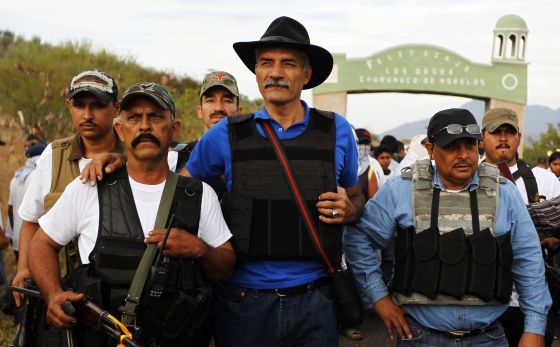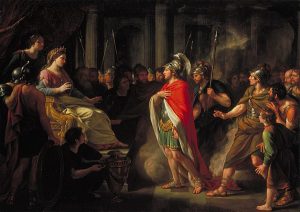It is estimated that, by the 1980s, Mexico’s drug cartels were slowly forming and beginning to operate. By the early 2000s, their presence was increasingly felt through the wave of violence and crime that struck Mexico. This would propel the issue of drug cartels and how to deal with them to the forefront of Mexican public policy. In 2006, newly elected Mexican President Felipe Calderon was faced with stopping the onslaught of violence and crime. Just days into his term, Calderon sent 6,000 Mexican soldiers to the state of Michoacán to combat drug cartels in the area.1 This marked the start of the drug war in Mexico. Almost 12 years later now and the success of the drug war is still questionable. It is estimated that around 50,000 to 70,000 have perished in Calderon’s term alone and to date around 25,000 more have vanished without a trace.2 In some parts of the country, cartels have established themselves as the sole authority there.3 Facing record levels of crime and violence, some citizens in Michoacán have taken action into their own hands by forming self-defense forces.

The development of self-defense forces in Michoacán culminated from many factors. Michoacán is a central state in Mexico giving it an ideal location to be able to move things all over the country quickly. It is located along the coast, providing the option to export drugs via sea. Its economy is largely based on agricultural and mineral resources. Michoacán is known for cultivating avocados and lemons and for the many precious minerals that are mined in the state.4 These characteristics, unfortunately, make it an ideal location for drug cartels who send their drugs to different parts of Mexico and into the United States. In 2006, the state of Michoacán found itself crippled by drug violence and the state was a battleground for different cartel groups vying for control. Under Calderon’s orders, federal Mexican security forces were to combat the cartels and restore order to regions that were under cartel influence. This only led to violent confrontations between security forces and the cartels which ultimately increased the levels of violence and the death toll. The government was largely ineffective in fighting the cartels due to rampant corruption among officials.5 Overwhelmed and out gunned, the Mexican government went as far as calling on the UN to prevent the flow of high-powered weapons from getting into cartel possession.6

The first self-defense forces to form in Michoacán, formed in the city of La Ruana. Here, farmers were under the constant threat of violence and forced to pay protection money to the cartel. The cartel regulated the local agricultural economy and controlled where the farmers could export their produce and to whom they could sell. Cartels also imposed required payments on produce.7 In one such instance of enforcing control, it is reported that several tons of lemons on their way to be delivered were destroyed. In response to such an act, local farmers and field workers formed the first self-defense group to defend themselves, their land, and their produce. The cartel then cut off the city from receiving supplies in an effort to cripple the resistance. The self-defense group would begin to look for others to come to its aid and break the blockade. 36 other similar groups formed around Michoacán. In Tepalcatepec, after facing similar abuses as in other regions of Michoacán, the local livestock association voted to transform their organization into a self-defense force. Other community leaders around Michoacán were present as well when the various self-defense forces were integrated into one entity. It was then that Jose Manuel Mireles Valverde became a prominent leader of the Michoacán self-defense forces.8 By March of 2013, the movement had grown from around 250 to 600, and some press releases from the self-defense forces claimed they were up to 3,000 strong.9
Jose Manuel Mireles Valverde was a medical doctor. In 2013, he was taken hostage, tortured, and only released after his ransom was paid. During the same time, several members of his family were murdered. His neighbors were beheaded and their heads put on display. Due to his own experience with the cartel, he felt compelled to join and lead the self-defense forcesmed. In Teplacatepec, Mireles’ charisma propelled him through the ranks and he became a leader in the organization and its main spokesperson. Under the leadership of Jose Mireles, the self-defense forces spread to other parts of Michoacán. In his role, Mireles became a national figure of resistance that many loved and others, including the government, despised.10
At their peak, the self-defense forces took control of approximately 30 towns around Michoacán. Eventually, the self-defense forces found themselves mired in controversy. By taking up arms and at times opposing state officials, the federal government cracked down against self-defense forces. Legally speaking, the self-defense forces were in violation of Mexico’s Firearms and Explosions Act by arming themselves and thus faced a legal predicament of establishing themselves as a legitimate group. In addition, they opposed the various cartels and the government because corruption was rampant among government officials who work alongside the cartels. The group refused to lay down their weapons despite threats of imprisonment and to be forcefully disarmed.11 Jose Mireles, was the primary targeted of government actions because of his prominent role. Eventually, he alongside dozens of self-defense forces was arrested. The group’s imprisonment was nothing short of controversial and ultimately displayed the attitude the Mexican government had towards its citizens who were simply trying to restore order in their state. Mireles was imprisoned, and after a public apology, his charges were dropped but he remained in custody for almost 3 years.12

Ultimately, the self-defense forces had to disband and some were absorbed by a newly created police force. After some began to question the leadership of Mireles and Mireles’ imprisonment, there was no longer clear leadership. Mireles’ bodyguard, a man by the name of Estanislao Beltran, who is more popularly known as “Papa Pitufo,” “Papa Smurf,” had also risen among the group and many followed him. The newly created rural police force was a subject of much contention and despite Mireles’ opposition to it, Estanislao Beltran and those who chose to follow him joined the new force. The rural police force operated similar to the self-defense force groups but had its authority come from the government and ultimately was controlled by the government. Other groups disbanded and went back to their normal lives, refusing to join. In Michoacán, this ended the rise of self-defense forces.13
The self-defense forces that formed in the Mexican state of Michoacán, formed out of a need to protect the rights and security guaranteed to all persons that the government could not provide. This group of citizens took it upon themselves to restore law and order, protect themselves, their communities, and their livelihoods. Mireles various times explained that their movement had grown so large because everyone in Michoacán had experienced some sort of pain caused by the cartel. He believed that by trying to secure the basic rights that they are entitled to by their governments and by being supported by the people, that they had legitimacy. They removed corrupt officials who worked with the cartel. They began as rag-and-tag armies that soon developed into a well-armed, efficient fighting force that was able to push the cartels out of areas that the federal forces for years had failed to do.14 Since their inception, they requested the support of the government in their mission and while there was limited coordination between the two, ultimately the government came to oppose them and see their downfall as if they themselves were a cartel.15 In some instances, government forces failed to act entirely as the cartels decimated cities, leaving it up to self-defense forces to protect the people.16 They faced a choice of being institutionalized into the corrupt system that had forced them to take action or remain insubordinate and put into question the legitimacy of the Mexican Government. It was never the mission of the self-defense forces to overthrow or undermine the legitimacy of the government. While they claimed legitimacy by being supported by the people, they tried to step in and fill the role of protector that the Mexican government could not provide. Considering the shortcomings of the Mexican governments, it was not ill-placed to rise up and create these self-defense forces, but by doing so undermined their own legitimacy. But in such a corrupt system how else could they bring about change? It was and continues to be the Mexican government who his culpable of the injustices suffered by, not only the self-defense forces in Michoacán, but by Mexican citizens all over the country who continue to suffer at the hands of vicious drug cartels. The self-defense forces of Michoacán represent a desperate effort ultimately stifled into silence and complacency.
In the past couple of years, there has been a resurgence of violence. Since the dismantlement of the self-defense forces, Michoacán continues to be one of the most violent states in Mexico. Jose Mireles has continued to be a critic of a government for its inability to reestablish law and order in Michoacán and other parts of Mexico. The 2018 election of Andres Manuel Lopez Obrador as Mexico’s new President suggests change and a call to action by Mexican citizens all over the country to end the violence that has plagued them. There will be much anticipation to what his administration will do when his government takes power on December 1st, of this year (2018).
- Antonio Fuentes Diaz and Guillermo Paleta Perez, Violencia y Autodefensas Comunitarias En Michoacan, Mexico, Iconos, Revista de Ciencias Sociales, no. 53 (September 2015), 175. ↵
- Alejandro Rodiles, Law and Violence in the Global South: The Legal Framing of Mexico’s ‘Narco War, Journal of Conflict and Secuirty Law, no. Issue 2: 269. ↵
- Andres Galeana Abarca, Ungoverned Spaces in Mexico: Autodefensas, Failed States, and the War on Drugs in Michoacan, (2014), 13-19. ↵
- Antonio Fuentes Diaz and Guillermo Paleta Perez, Violencia y Autodefensas Comunitarias En Michoacán, Mexico, Iconos, Revista de Ciencias Sociales, no. 53 (September 2015), 175-176. ↵
- Antonio Fuentes Diaz and Guillermo Paleta Perez, Violencia y Autodefensas Comunitarias En Michoacán, Mexico, Iconos, Revista de Ciencias Sociales, no. 53 (September 2015), 174. ↵
- “Mexico Calls on UN to Help Control Flow of High-Powered Weapons to Drug Gangs,” UN News, (September 2011). ↵
- Enrique Guerra Manzo, Las Autodefensas de Michoacán, Politica y Cultura, no. 44 (October 2015), 16. ↵
- Antonio Fuentes-Diaz, Narcotráfico y Autodefensa Comunitaria En Tierra Caliente, Michoacán, México / Drug Trafficking and Community Self-Defense in Tierra Caliente, Michoacán, Mexico, CiencaUAT, (Universidad Autonoma de Tamaulipas, 2015), 76-77. ↵
- Enrique Guerra Manzo, Las Autodefensas de Michoacán, Politica y Cultura, no. 44 (October 2015), 13. ↵
- Matthew Heineman, Tom Yellin, Jose Mireles, and Tim Foley, Cartel Land, (Hollywood, California) Paramount Pictures, (2016). ↵
- Matthew Heineman, Tom Yellin, Jose Mireles, and Tim Foley, Cartel Land, (Hollywood, California): Paramount Pictures, (2016). ↵
- Maria Verza, “Mexican Judge Grants Vigilante Leader’s Release on Bond,” AP English Worldstream- English, Associated Press DBA Press Association (May 2017). ↵
- Enrique Guerra Manzo, Las Autodefensas de Michocacan, Politica y Cultura, no. 44 (October 2015), 17. ↵
- Matthew Heineman, Tom Yellin, Jose Mireles, and Tim Foley, Cartel Land, (Hollywood, California) Paramount Pictures, (2016). ↵
- Enrique Guerra Manzo, Las Autodefensas de Michoacán, Politica y Cultura, no. 44 (October 2015), 17. ↵
- Enrique Guerra Manzo, Las Autodefensas de Michoacán, Politica y Cultura, no. 44 (October 2015), 21. ↵



54 comments
Eliezer Leal
The story this article tells is heartbreaking. People left with no choice but to fight back against an oppressing force that is the cartel were brought down by the government that was supposed to “protect” them. The amount of corruption within the Mexican government is ridiculous, governments are put in place to keep chaos and disorder in check, not join it. For people under such a government is terrifying because you can only trust those who have experienced the same pain of oppression you did, one phone call to the wrong officer about information of the cartel could easily put a target on you and those you love. It truly is heartbreaking to hear how corruption is so prominent in various countries.
Andrea Degollado
This article really hits home for me. I come from the RGV and I used to go to Mexico all the time but since the rise of violence that occurred that stopped, also my friend family member was affected by these events and was even taken. I believe one of the main factors that has intact helped the cartels is the government. The government instead of opposing it and trying to stop it, does nothing bu join and profit from these criminal organizations.
Alexander Avina
I only knew about the conflict between the drug cartels and Mexican government from watching a little portion of the Netflix show “Narcos: Mexico.” I didn’t know some of the background about this story. This was a really interesting article about a subject that I wasn’t too familiar with. I enjoyed hearing about this subject on a deeper level. This article was written on a very intriguing subject. This was written very well and included many important facts that I didn’t know before. The article kept me interested all the way through.
Kasandra Ramirez Ferrer
I think one of the main factors Mexico has been so corrupted it’s because of the cartels and influence they have on the government. Cartels not only in Mexico but in the U.S.A as well had affected thousands of innocent lives, many people have lost parent, siblings, friends, and people who they care for because of the influence of drugs, gang fights or even cartel themselves were the ones who took their lives. Sadly, Michoacan is one example of these situations and now people leave everything behind and go looking for a safe place to live.
Rosa Robledo Martinez
My dad is actually from Michoacan, he told us as we were growing up that he would never want to live there or go back home. But we tend to go at least once a year, I remember that we didn’t go to Mexico for over four years, because of the cartels and what they were doing. Back then Mexico used to be a beautiful place where kids can have fun playing around in the streets, but as time passes the gangs were getting stronger. Kids were forced to sell drugs, steal and do what they were told to do if not they would have to suffer. It stinks that there’s evil people in the world that do what they want to get what they desire. This article allowed me to be more aware of my own roots and what the people did back then and till this day.
Sebastian Portilla
Mexico is in a very difficult place. They’ve been in the midst of a war for the last few decades. No president or leader can cease it. It’s been on going, many people have lost their lives because of it and many more people will continue to if it is not dealt with. The country is so poor that people turn to cartels to take care of them. This article was very well-written. I wish maybe it went into more depth between the relationship of the citizens of Mexico and the cartels.
Sierra Salas
This article opened my eyes to the injustices taking place in Michoacán and around Mexico. Reading this article made me imagine the pain that the citizens of Michoacán are experiencing. I think due to the corruption deeply rooted in the Mexican Government, the citizens of Michoacán had no other option than to form a self-defense force. I think it is amazing how these farmers and other citizens created a some-what successful self-defense force out of almost nothing. They took matter into their own hands, which is a terrifying thing to do, but not as terrifying as the heinous acts of injustice that they had experienced.
Mark Dominguez
A very enlightening article, it is baffling to see how powerful drug cartels have had control over the government and people in Mexico, and how they continue to operate with relative impunity today. It seems that the efforts by authorities to curtail their influence have failed and unfortunately the citizens had to do what the government’s forces were suppose to do.
Raul Vallejo
It is always terrible whenever someone has to experience something as terrible as what Jose Manuel Mireles Valverde had to. Fourtanetely Jose took that experience as a matter that he had to put things into his own hands or else no one else was going to do anything. After they got shut down for just helping their own communities, people all around Mexico opened their eyes and realized that the government were shutting down the wrong people. Jose helped change the way the people reacted to this violence through his pain.
Jose Maria Llano Aranalde
It’s crazy to see the control that this cartels have on the people and the government in Mexico. This issue doesn’t just effect people in Mexico but people all across Central America as well. It was great to see the people of Michoacan get together and protect each other. It shows how strong the community is and how tired they were of constantly having this battle. They unfortunately have to do the work that the police are not willing. I applaud the citizens for taking action but it saddens me that they have to fight in their own.